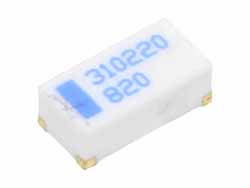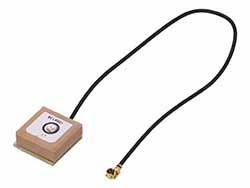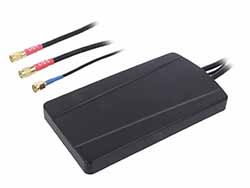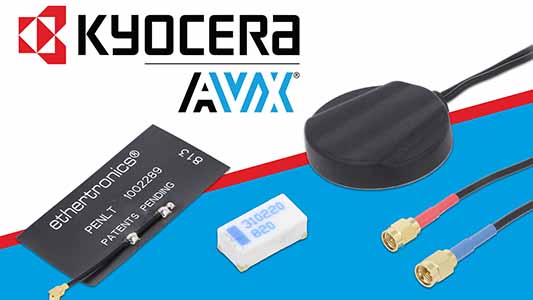Wireless communication is not only the domain of consumer devices such as smartphones and tablets. Practically, almost every IoT circuit communicates using one of the popular standards: Wi-Fi, Bluetooth, LTE or ZigBee. However, the strength of the radio signal, and thus the data transmission range and rate, are not only dependent on the module used in a given device – choosing the right antenna is also a vital factor…
The Kyocera AVX assortment of antennas is an extension of the offer that was formerly marketed by Ethertronics (which is now part of the Kyocera AVX Group). These are top-quality, highly specialist components designed to be operated using popular communication standards. They are designed with compact size, mechanical robustness and IoT applications in mind. These include industrial equipment for the transmission of M2M () data.
Wi-Fi/Bluetooth antennas
M310220
Ceramic surface-mount (SMD) antenna.

Most devices using Wi-Fi and Bluetooth BLE connectivity are miniaturised circuits. They communicate over short distances (usually up to several metres) and have to be equipped with the most compact antennas possible. Fortunately, the standard transmission frequencies of these communication standards (2.4 GHz and 5 GHz) allow the construction of microscopically sized radiators, e.g. ceramic elements enclosed in SMD packages. Such antennas are, naturally, available from the Kyocera AVX range. Their case is a 2×1.2×0.55 mm cuboid (selected models). The energy gain of such components falls within the range of 1–1.88 dBi. They offer superb omnidirectionality, as illustrated below. This ensures that the signal level (of the typical linear polarisation) is not affected by the spatial orientation of the circuit.
radiations_patterns

The Kyocera AVX assortment includes SMD antennas which can be embedded in a PCB (i.e. “demo” versions), fitted with a coaxial SMA connector. These are excellent aids to facilitate circuit prototyping and testing stages.
The manufacturer also provides solutions catering for devices that require the antenna to be placed away from the circuit for optimum positioning. This may be necessary, for example, in the case of embedded sensors or controllers housed in a switch cabinet. Solutions designed for such applications include antennas placed in sealed enclosures with factory-fitted connection cables (1 m, SMA plug).
Keep in mind that antennas intended for the 2.4 GHz band are compatible not only with Wi-Fi networks and Bluetooth modules, but also with a number of other communication standards, e.g. ZigBee.
GNSS antennas

The GNSS acronym stands for . The first widely used solution of this type (and which is still the most popular one) is, needless to say, the American Navstar GPS(). In recent decades, alternative systems have also emerged: the European Galileo and the Chinese BeiDou. All of these satellites send signals at similar frequencies, in the range of approximately 1.1–1.6 GHz. Consequently, manufacturers are able to develop antennas compatible with each and every GNSS system available.
1004138GPS antenna with an LNA amplifier and an IPEX (MHF) connector.
As in the case of the previous product category, here too Kyocera AVX supplies antennas manufactured in the form of small SMD components. Such solutions are mainly used in mobile devices. If the space inside the enclosure of your target device allows the integration of a slightly bulkier antenna, you should consider the 1004138 ceramic active receiver, which houses both the antenna and the LNA () in a single 13x13x6.8 mm body, thereby guaranteeing excellent reception of satellite signals even in difficult conditions (e.g. inside buildings or vehicles).
Multi-band variants
X1005245LSA3SA10A2

“Combo” antenna for simultaneous communication using two different standards.
A subcategory of antennas that could not be missing from this list are multi-band (“combo”) solutions. These are most commonly applied in systems for monitoring car fleets. Units placed in cars communicate using at least two technologies. Firstly, they acquire data from the GPS system to locate the vehicle and then use the LTE/GSM network to transmit the location information to a server, to a database. Kyocera AVX offers antennas that combine solutions operating at GSM and LTE frequencies in a single housing. They are equipped with SMA connectors and cables (1 m). This makes it possible to place them in a spot that provides good reception and transmission performance. Thanks to the IPX7 rating, they can even be fixed outdoors, e.g. outside the cab of a truck, if required.
GSM/LTE antennas

Applications of GSM and LTE technologies go beyond smartphones and other consumer devices. Internet access that is independent of the local infrastructure (e.g. Wi-Fi) is an essential feature of many IoT devices, especially those for M2M () communication. Such access is used by environmental conditions monitoring stations, components of urban installations (street light controllers, traffic sensors). For some devices, the capabilities of standard GSM communication are sufficient to fulfil their role. This would be the case, for example, of intrusion prevention systems, which send a text message in the event of unauthorised access to a restricted area.
1002289Kyocera AVX LTE antennas can be as thin as 0.2 mm.
Kyocera AVX GSM/LTE antennas come in several formats. Besides SMD components (49.6x8x3.2 mm), products enclosed in a housing, equipped with a connecting cable; rigid antennas mounted in an SMA socket, and plastic-coated radiators with a thickness of less than 0.2 mm are available. The latter feature a connection cable equipped with the popular U.FL connector, which can be found in numerous communication modules. The range of those products includes antennas operating at various LTE channel bandwidths, at the lowest (starting from 690 MHz) and high frequencies (up to 2.7 GHz).
RF antennas

M620720-01Prototype demo board equipped with an SMA connector and an SMD antenna.
Finally, let’s take a look at antennas dedicated to RF applications, i.e. short-range communications (remote controllers, remote switch controllers, etc.). Modules of this type operate at ISM bands (), the frequencies of which vary and depend on the applicable national regulations. SMD antennas from Kyocera AVX are adapted for two frequently used bands: 863–870 MHz and 902–928 MHz. The components feature an energy gain of 0.75 dBi.
Also in this category, the supplier offers prototype PCBs equipped with an SMA connector and a pre-installed antenna.












